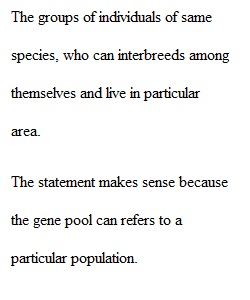


Q 1. What is a population? List three populations. 2. “We like him, he seems to have a terrific gene pool,” say the parents upon meeting their daughter’s boyfriend. Why doesn’t their statement make sense? 3. Explain the differences among an allele frequency, a phenotypic frequency, and a genotypic frequency. 4. What does Hardy-Weinberg equilibrium mean? 5. Why is Hardy-Weinberg equilibrium more a theoretical state than a common, real situation for genes that affect the phenotype? 6. What are the conditions under which Hardy-Weinberg equilibrium cannot be met? 7. Why is knowing the incidence of a homozygous recessive condition in a population important in deriving allele frequencies? 1. Give three examples of how population genetics can be observed in everyday life. 2. Why are Hardy-Weinberg calculations more complicated if a gene has many alleles that affect the phenotype? 3. How can evolution occur at a microscopic and macroscopic level? 4. Two couples want to know their risk of conceiving a child with cystic fibrosis. In one couple, neither partner has a family history of the disease; in the other, one partner knows he is a carrier. How do their risks differ? 5. How does calculation of allele frequencies differ for an X-linked trait or disorder compared to one that is autosomal recessive? 6. Why might understanding Hardy-Weinberg equilibrium be important in understanding epidemiology (the patterns of infectious diseases in populations)? 7. Profiling of Y chromosome DNA implicated Thomas Jefferson in fathering a child of his slave, discussed in chapter 1. What might have been a problem with the conclusion? Case studies Maple syrup urine disease (MSUD) (see Reading 2.1) is autosomal recessive and causes mental and physical retardation, difficulty feeding, and a sweet odor to urine. In Costa Rica, 1 in 8,000 newborns inherits the condition. What is the carrier frequency of MSUD in this population?
View Related Questions